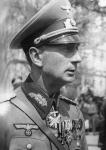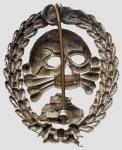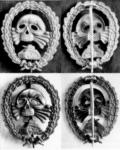-
Posts
2,284 -
Joined
-
Last visited
-
Days Won
6
Content Type
Profiles
Forums
Blogs
Gallery
Events
Store
Everything posted by PKeating
-
-
I spent some time with 271. Fallschirmj?ger and they were a fine bunch of lads with real ?sprit de corps. The run-of-the-mill national service soldiers were rather like conscripts anywhere: the best of them were on a level with a TA battalion of The Queen's Last Resorts and the worst evoked visions of a depot full of sickies excused boots. I remember seeing one BW infantryman - I use that term loosely - in sneakers and a hairnet, with visible rust on his G3. But hey, he'd have done just fine jamming up the runners of T72s had Ivan ever rolled across the border. National Service is a good idea but ought to be for a minimum period of two years. It shan't happen in Europe anytime soon because our rulers fear the notion of citizen soldiers with the military training that might enable the people to overthrow governments by force of arms in the absence of any meaningful say in who is running the show. Politics aside, on a more mundane level, national service would certainly remove a lot of the little hoodies and cornerboys from our streets for a while, which would reduce the noise levels and generally improve everyone's quality of life. It might even help some of them towards evolving into members of the species homo sapiens. PK
-
The ribbon or riband is an integral part of any medal issued with one but I disapprove of the practice of putting a mint riband through the ring of a mint medal that comes in a case or a packet. Call me precious or anal if you like but such an ensemble should surely be displayed as is. PK
-
Correction: the vendor isn't breaking up the group but the estimate is ?13.500,00, which is a lot but which is the market price. The Naumann badge and 1940-dated certificate were offered at $10,000.00 a couple of years ago and found a buyer quite quickly, so I gather. I remain curious about the differences between the Naumann and Lechner badges. Are these due to different dies as a result of die breakage? PK
-
If it is, and it seems to be, then someone is breaking up the group. Vandals! PK
-
Here are the Neumann and Lechner badges side by side. The late Bill Stump, who had seriously studied these badges back when the period was more accessible through living witnesses and so on, had this to say about the Lisbon badges: By "2nd Type", Bill meant the German-made badges actually awarded to Condor Legion tankers in Berlin in 1939 and 1940. A typical minimum production run at the time for any firm tooling up to strike badges and medals was five hundred units. With just 415 recipients of the badge to consider, it seems unlikely that the OKH would have ordered up more than the equivalent of two or perhaps three minimum production runs. Perhaps they just ordered enough for the recipients, hence a firm like Otto Schickle and perhaps one or two others (according to photographic evidence) seeing the chance to make duplicates for retail sale to the recipients. Regarding the Type 1 badge from Lisbon, it was reported by some sources that the die broke and that a second die had to be made. So this is true, it means that there were in fact Type 1a and Type 1b badges. Now, if you look very closely at the Neumann and Lechner badges, you can see slight differences in the teeth and the bones. The Neumann badge is too worn to afford a really fruitful comparison but the differences are there. So, are we looking at Type 1a and Type 1b badges here, or is there a more sinister explanation? Once the Lisbon die broke, was a second die made by the supplier to fill the order? PK
-
-
Maybe. Perhaps the creation of a half-tone photo from a well-made fake is a more credible hypothesis. Just kidding, Brian! Joke! But it is always as well to explore the possibilities and never to underestimate the criminal initiative and imagination where there is money to be made. One can never reproduce a die exactly and cast copies are always detectable because they are smaller than the originals. What better, then, to produce a variant and then produce proof to back it up? The fakers have been doing this with Third Reich stuff since the 'sixties and probably the 'fifties. Some crooks even became 'authors', producing entire books primed with photos of "variants" and "prototypes" of items they had had made and which they punted out to carefully chosen buyers. This was before the internet, of course, and the revolution it brought in the form of exchange of information between collectors. But these issues have been discussed at length in the past. If the half-tone image really dates from 1940, then your badge probably dates from 1940 too. PK
-
How can we be sure of that? Given the intellectual level of the majority of Third Reich militaria collectors - calling to mind George Petersen's immortal remark about "the dirty fingernail brigade" - one doubts if they would understand what they were looking at even if they saw a period reference work. Most of them can hardly get it together to study contemporary reference works. Not that there are many worth studying, of course. Joking aside, you cannot assume that other copies of this catalogue do not exist or have not found their way into the hands of nefarious people. Forgers go to quite amazing lengths sometimes to set up their scams, believe me. I knew some of the best in the business around a quarter of a century ago and I regularly see their products on internet and at shows, and in collections. I mean, if you really want to flirt with paranoia, who's to say that someone didn't make a badge and then fake a catalogue? Easily done, if you know what you're doing. PK
-
Brian, Thanks for your PM. Having found pictures of your badge on another website, I would say that if the half-tone catalogue photo dates from 1940, then your badge appears to be an absolutely genuine 1940 period example by Otto Schickle. There are some apparent minor differences, like a slight disparity in the angle of the tanks, but given the number of other ways in which the badges appear to be identical, the tank angle difference could be down to photographic distortion. There again, an enterprising faker might have given the 1940 image to a die-cutter who copied the obverse as faithfully as he could but made the inevitable errors of perspective because he was working by hand back in the early 1970s rather than with the laser technology of today...which still isn't perfect. But this is just hypothesis. The badge is probably OK. PK
-
Sorry Brian. I didn't mean to upset you. As I have not actually seen your badge as a whole, I cannot agree that it resembles the badge in the half-tone, retouched image but I don't doubt you. I would like to see obverse and reverse views of it because I am interested in seeing it. Having a badge for thirty years just means that it has been around since 1975. I really can't see the flaw on the badge in the photograph from the original wartime catalogue posted by Gordon Williamson. All I see are pixels. Perhaps Gordon can scan the relevant bone and post a high res close-up. PK
-
Just to illustrate my last point, look at these three Heer Para Badges by C E Juncker. From left to right, Type 1, Type 2 and Type 3. The wreaths all look a bit different, don't they? Well, they were all struck on the same set of dies, used in 1937/38 and again in 1943/44. They're just finished differently around the edges. PK
-
It is due to hand-finishing, Jacques. The form of the external and internal edges of these badges depends on how much die-flashing was filed off by the person finishing the badge. Collecting Luftwaffe flight badges as you do, you will be familiar with this. The main points to look at are die-struck surface characteristics and details, not filed edges. No two Condor Legion Tank Badges from the same dies have identical external contours. If you look at the retouched catalogue photo, you can actually see the die-flashing between the leaves and the bones. It's heavily pixelated because of the half-tone process but it is there. PK
-
Brian, Could we see your badge as a whole? There is an apparent die flaw visible in the half-tone picture but the picture has been printed in half-tones and then, I would say, retouched so who is to say that evidence of a die flaw was not added by someone who wished to validate a die flaw on badges that looked like Schickle products? These fakers and forgers are a cunning lot, you know! The image on the catalogue page posted by Gordon seems untouched and is a better photograph than the half-tone one yet I cannot see any traces of the die flaw. It seems strange that traces of a die flaw would be left intact by an art room retoucher, doesn't it? I also can't see any die flaws on the badges posted by Jacques. And nor can I see any traces of any die flaw in the close-up of the Shickle badge in the wartime photo. So, if your badge was struck on the same dies as the badges in the unretouched catalogue photo, the wartime photo and the two studies of badges in collections, then it must postdate all those badges. Gosh! This is like the Steinhauer & L?ck thing, isn't it? I believe Otto Schickle was in business after WW2. PK
-
I'm not jumping to conclusions. I am basing my conclusion on a careful comparison between the outline an d other characteristics of the close-up of the badge in the wartime photo and the picture of the badge in the wartime Schickle catalogue posted by Gordon. Look at the bones. Look at the top of the wreath and the outline of the leaves, in particular the leaf that protrudes more than the others. It is possible that they were not struck on the same dies but, IMO, improbable given the peculiarity of the design with that protruding leaf that is a borderline design flaw, rendering the wreath asymetrical. But that is only my opinion, Brian. If your opinion differs from mine, no problem. PK
-
I agree that it is a photograph. I think the term we're looking for here is 'half-tone'. Here it is again, alongside the pictures Jacques posted of Shickle-style badges. These certainly look the same as the Schickle badge in the catalogue page posted by Gordon and the badge worn in the photo above. The deathheads are the same. Below is Jacques' picture, in half-tones. PK
-
Well, Gordon, I'd say the badge this tanker is wearing came from Otto Schickle. It is clearly the same as the badge in the catalogue. PK
-
Well, Gordon, I'd say the badge this tanker is wearing came from Otto Schickle. And here, borrowed from another thread on GMIC, is a Wernstein PKA with a hinge and pin assembly that looks very like that on the 1939 badge as awarded to Paul Z?ndorf. I know that firms bought in hinge and pin assemblies but this is such an 'un-German', Iberian set-up that I think it's not unreasonable to wonder if it came from stock left over from the production of the Condor Legion Tank Badge and to suggest that the award badges were made by Hermann Wernstein. PK
-
Well, only two of the badges I have posted are originals. The others are either fakes or questionable. I don't think any of them conform to the image in the wartime Otto Schickle catalogue. In any case, as I said, the images in period catalogues are either drawings or retouched photographs so while they serve as a rough guide, they do not constitute proof for the purposes of authentication because they are simply not of sufficiently high fidelity to absolutely sure. It is rather like trying to identify or, rather, authenticate something using the Dr Doehle book. However, I would say that I am inclined to believe that your badge is indeed an original wartime variant by Otto Schickle. Other variants certainly existed, as wartime photographs in this thread show, but with the level of skill and effort that has evidently been put into producing fakes of this badge, fakers have obviously referred to period photographs to produce quite convincing items. It is a tricky subject and my advice to inexperienced potential buyers is to stick to badges that are accepted without question - by serious students of the subject and by dint of provenance, I hasten to add - as either textbook Lisbon pieces or 1939 award pieces. Pay the price and enjoy peace of mind because the minute you have to start justifying something to the peanut gallery, it's always going to be hard to move it on and recoup your money. PK
-
The reverse. Close...but no banana! Note particularly the hinge assembly: the base is too small so the cutout is redundant. There are plenty of other differences but you can have fun spotting them.
-
Comparison of a known original (the Z?ndorf badge) and a dangerous fake of it, offered a while ago by an American dealer. PK
-
Z?ndorf's nachla? was broken up by Kai Winkler. I heard that there was more than one badge but the one I have shown is the type awarded before the parade in Berlin in June 1939. It could be by Hermann Wernstein as a very similar hinge and pin assembly has been seen on this maker's Panzerkampfabzeichen. That said, the hinge and pin assembly appears to be a copy of the set-up on the second pattern Lisbon badges, which is logical as the German firm was probably lent a Lisbon badge and told to copy it. Here is another photo of Z?ndorf. I enjoyed owning this badge but swapped it for something I just could not refuse! PK
-
And here is the badge received by Paul Z?ndorf during the award ceremony in Berlin in 1939. This is the type of badge over which hangs no question mark. PK















